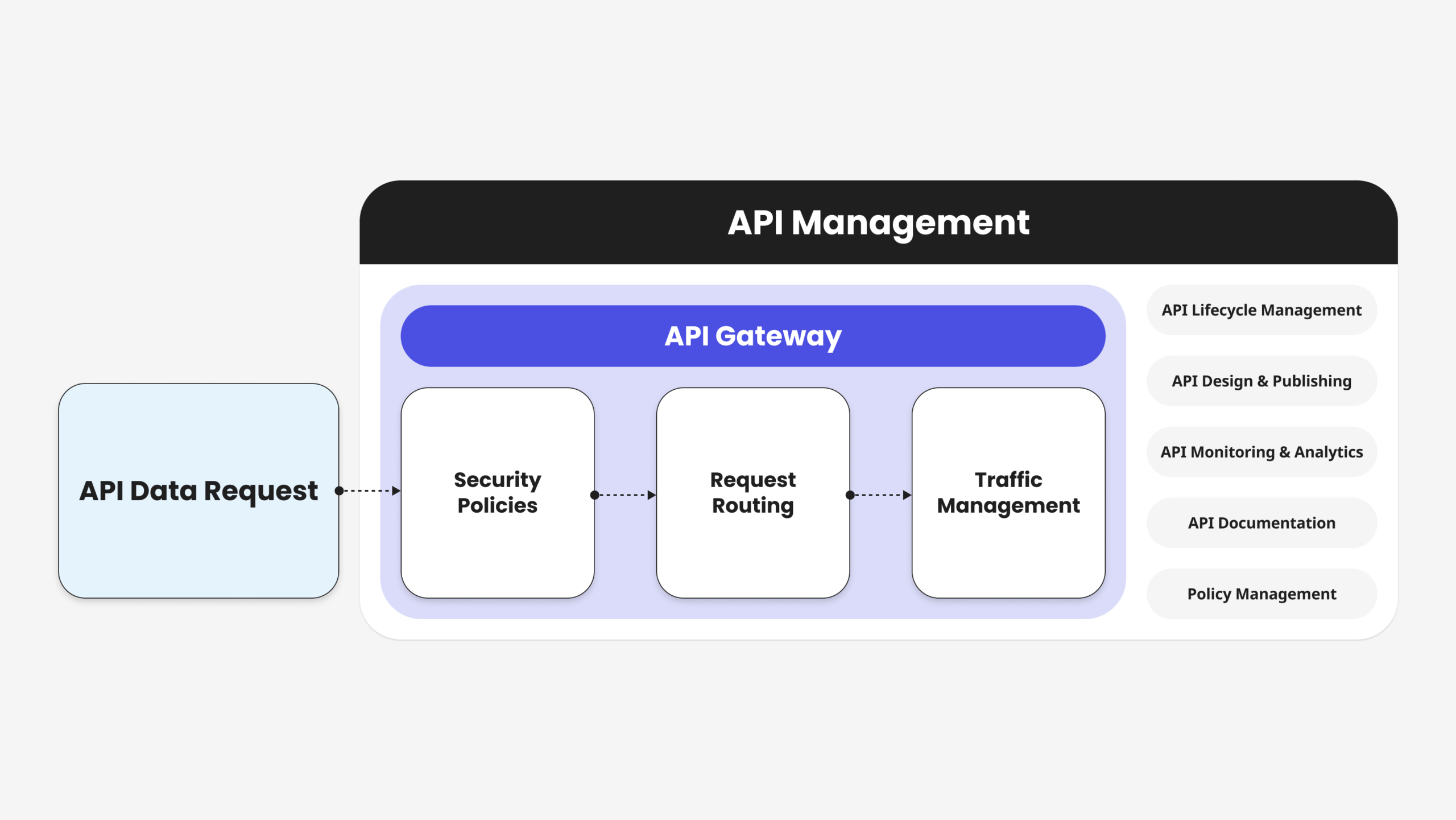Application Programming Interfaces (APIs) enable different software components, services, and systems to communicate and collaborate seamlessly. Understanding how APIs work and how they are managed is critical for software innovation and development. This post will help explain the growing significance of APIs in modern software development and specifically the distinctions between API management and API gateways.
What Is API Management?
API management is a comprehensive set of practices and tools organizations use to create, secure, monitor, and maintain APIs effectively. It plays a vital role in ensuring that APIs are reliable, secure, and well-documented. That makes them valuable assets for driving digital innovation, enabling integration, and fostering collaboration in modern software development and business ecosystems.
API management includes designing and developing APIs with well-defined endpoints, request/response formats, and functionality. This ensures that APIs are easy to use and understand for developers. It also provides security measures such as authentication, authorization, and encryption that protect API endpoints and data. API management also helps control access to APIs, ensuring that only authorized users and applications can access them.
API management is also key for developers. An essential component of API management is the developer portal, which provides a user-friendly interface for developers to discover, access, and test APIs. It includes documentation, code samples, and tools to facilitate API adoption. API management encourages engagement with external developers and partners by providing them with the tools and resources they need to integrate and build upon your APIs.
API Management Platforms
API management platforms offer real-time monitoring and analytics capabilities. This allows organizations to track API usage, performance, and health while enabling them to detect and address issues promptly. API management platforms are designed to handle API traffic efficiently and scale resources as needed to accommodate increasing demand. They can also control the rate at which clients make API requests, which ensures fair usage and protects backend systems from being overwhelmed.
Finally, APIs often evolve over time. API management platforms help manage different versions of APIs, ensuring backward compatibility and providing a smooth transition for developers using older versions.
Dig Deeper into API management: Simplifying API-Led Connectivity With a Modern Integration Platform
API Management Components
API management components enable the creation, security, monitoring, and governance of APIs throughout their entire lifecycle. Numerous components go into API management, including:
- API Design: Creating well-defined endpoints and specifying the API’s function, including request and response structures.
- API Gateway: Serving as the entry point for API requests, responsible for tasks like routing, load balancing, and request and response transformation.
- API Security: Protecting APIs and their data with authentication, authorization, encryption, and access control against unauthorized access and attacks.
- API Lifecycle Management: Managing the complete lifecycle of an API, from design and development to deployment, versioning, and eventual retirement.
- API Developer Portal: A central hub for developers to discover, learn about, and interact with APIs, providing documentation and resources.
- API Analytics: Collecting and analyzing data related to API usage, performance, and metrics to gain insights and identify areas for improvement.
What Is an API Gateway?
An API gateway is a crucial component in the API ecosystem that acts as a central entry point for API requests. It receives incoming requests, routes them to the appropriate backend services, and provides various functionalities such as load balancing, request and response transformation, caching, and security enforcement.
Within the API management ecosystem, an API gateway plays a pivotal role in enhancing the reliability and performance of APIs. It manages the flow of requests between clients and backend services, ensuring seamless communication and optimizing resource utilization. When a client initiates a request, the API gateway is the initial point of contact, taking charge of request routing, load balancing, and even request and response transformations. This routing feature directs incoming requests to the appropriate backend server. At the same time, load balancing ensures that the requests are evenly distributed among multiple backend servers or instances, improving performance and fault tolerance.
API gateways provide a secure layer by enforcing authentication and authorization, protecting against DDoS (distributed denial-of-service) attacks, and enabling encryption. Additionally, they distribute incoming traffic across multiple servers for load balancing, ensuring high availability and improved performance.
Within the broader API management ecosystem, the API gateway fits seamlessly into the runtime aspects of API communication. API management encompasses various functions, including API design, creation, monitoring, security, analytics, and developer engagement. The API gateway is integral to these functions by ensuring that APIs are secure, performant, and accessible. Ultimately, the API gateway is employed for enhancing security and load balancing to facilitate scalability and simplifying client interactions with backend APIs, making it an indispensable component in contemporary software architecture.
API Management vs. API Gateways
API management and API gateways are important and have very different roles in the API ecosystem. Together, they form a powerful combination for managing and optimizing APIs in modern software architecture.
The main difference between the two is:
API Management: Offers a comprehensive solution for designing, securing, monitoring and governing APIs across their lifecycle.
API Gateway: Serves as a specialized component within that management suite.

What does API Management do?
API management involves far more than an API gateway. API management encompasses the end-to-end governance and administration of APIs. It provides a multifaceted framework for designing, deploying, securing, monitoring, and optimizing APIs throughout their lifecycle. During design and development, management involves creating well-structured APIs with clear specifications and documentation to ensure ease of use for developers.
After launch, API management addresses security concerns through mechanisms like authentication, authorization, and encryption to protect API endpoints and sensitive data. Monitoring and analytics are also a part of management, and API management is responsible for the entire API lifecycle. The API management software oversees versioning, deployment, and retirement, ensuring smooth transitions as APIs evolve.
API Management Use Case
Let’s say an IT services company offers cloud-based infrastructure solutions to various clients, including businesses, educational institutions, and government agencies. They must efficiently manage and secure APIs to provide seamless access to their cloud resources while ensuring data privacy and compliance. The IT services company can utilize API management in the following ways:
- API Design: The company designs APIs with well-defined endpoints for services like cloud storage, virtual machines, and data analytics. Clear request and response structures are established for easy integration by clients.
- API Security: The IT services company implements robust authentication and authorization mechanisms within their APIs to protect sensitive client data and ensure compliance with industry regulations. Encryption secures data in transit and at rest.
- Developer Portal: They create a portal that serves as a centralized hub for clients to discover, learn about, and interact with the APIs. Documentation, code samples, and testing tools are provided to facilitate integration.
- API Analytics: API analytics tools collect and analyze data related to API usage, performance, and error rates. Insights gained from analytics help optimize API performance and identify areas for improvement.
- API Lifecycle Management: The company manages the entire API lifecycle, from initial design and development to deployment and version control. They ensure backward compatibility during updates to minimize disruption for clients.
With API management, the IT services company enhances security, streamlines integration, optimizes performance, supports scalability, and ensures compliance with industry regulations.
What does an API Gateway do?
An API gateway is a singular component of API management focused on optimizing communication between clients (such as applications or users) and APIs. API gateways are responsible for routing incoming API requests to the appropriate backend services. They distribute incoming traffic across multiple servers or instances to ensure high availability and improved performance, which also improves usage outcomes on the customer side of the operation.
Like API management, API gateways also have a role in security. The gateways can enforce security policies, protecting APIs from unauthorized access and mitigating potential threats. They also have other roles in traffic management, as they can modify request parameters or payloads and transform responses as needed, adapting data formats between clients and APIs.
API Gateway Use Case
Let’s say there’s a mobile banking application that serves millions of customers who access their accounts, make transactions, and view balances through APIs. Leveraging an API gateway is crucial for optimizing communication between the mobile banking app and backend services to improve financial visibility, accuracy, and customer experiences. The mobile banking application can leverage an API gateway to facilitate:
- Request Routing: The API gateway routes incoming requests from the mobile app to the appropriate backend services, such as account balance, funds transfer, or transaction history.
- Load Balancing: It distributes incoming traffic across multiple servers or instances to ensure high availability and improved performance, even during peak usage.
- Security Enforcement: The API gateway enforces strict security policies, including authentication and authorization, to protect customer account data from unauthorized access.
- Traffic Management: It can modify request parameters, handle request and response transformation, and manage rate limiting to ensure a smooth and responsive user experience.
- Caching: The gateway can cache frequently accessed data, reducing the load on backend servers and speeding up response times.
The API gateway ensures that the customer transactions are secure, responsive, and highly available while optimizing resource utilization on the backend. For teams that need to manage multiple gateways, federated management with an API Control Plane can help keep APIs secure, performant, and centrally managed.
Investing in an API Management Platform
Investing in an API management platform is paramount in today’s web development landscape. Your organization likely relies on APIs to enable digital transformation, enhance customer experiences, and drive business growth. The right API management platform simplifies the configuration and deployment of APIs, helping you get the most out of your data.
Boomi API Management, part of the Boomi platform, offers comprehensive support for the entire API lifecycle in any environment, simplifying the deployment and management of APIs without unnecessary complexities. Boomi empowers organizations to significantly reduce the time-to-value, enhance operational efficiency, and instill unwavering confidence in network security and reliability.
Looking for unified API Management? Go with a leader. Gartner® positioned Boomi as a Leader in the 2025 Magic Quadrant™ for API Management


 English
English 日本語
日本語